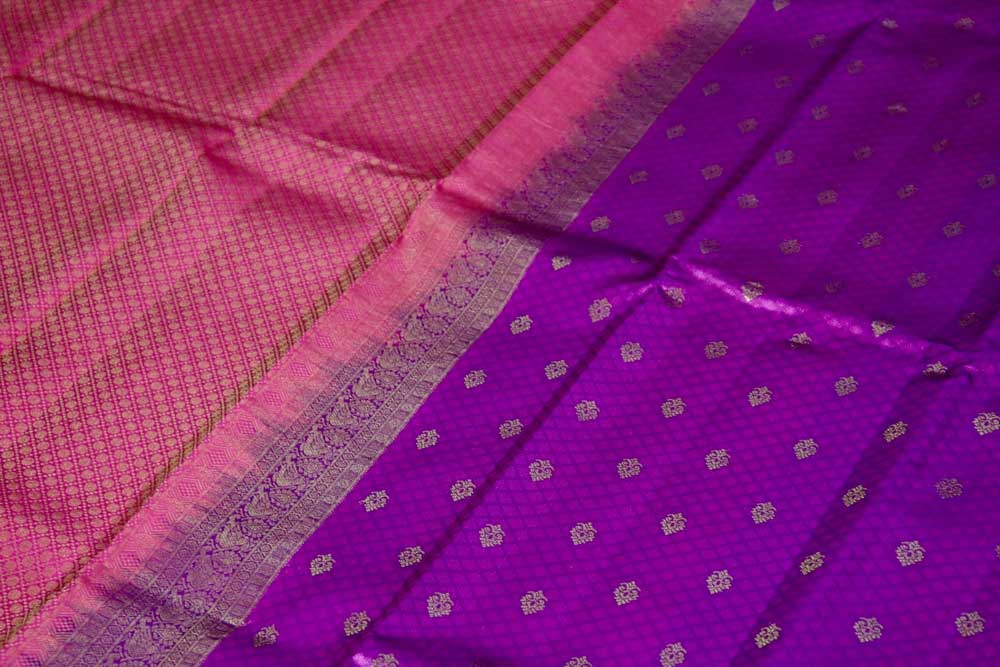One of India’s greatest singers MS Subbulakshmi unwittingly became a style icon of her times. Women from all over south India would flock to watch her performances, while also soaking in the beauty of her rich Kanchivaram saris - accessorised with her signature nose pin, diamond earrings, and fresh jasmine flowers adorning her bun. Her favourite colour was a deep sapphire blue, now nostalgically referred to among sari connoisseurs and stores as ‘MS Blue’. The colour soon became a rage among fashionistas, and even today, Kanchivaram-lovers clamour to purchase lush, regal silks in this timeless hue.
Kanchivarams embody the spirit of heritage and artistry, with an enduring appeal, regardless of shifting trends. Legend has it that Sage Markhandaya, the weaver of the Gods, wove the first Kanchivarams of lotus fibres, and the weavers or Kanchis are all his descendants. But myths aside, the actual history of the Kanchivaram weave can be traced back to the Chola dynasty, which began weaving in the city of Kanchipuram. Pavithra Muddaya, a textile revivalist since 1974 is the Co-Founder of Vimor and Founder - Vimor Museum of Living Textiles. She says, ‘To begin with, the majority of silk used in sari weaves is mulberry silk and comes from Karnataka. It is then sent to Benaras, Kanchivaram or any other centre and used in different parts of India or the world. We have been a supplier of yarn for ages, and the kind of quality needed for a Kanchivaram is very distinct. During the weaving process, when you set the warp, Kanchivaram is set in four-ply, to make the silk very thick. So what distinguishes this silk is the fact that it is very heavy. It is also highly twisted and you know it's pure Kanchivaram just by the sheer weight of it.’.
She adds, ‘There is a tendency to assume that Kanchivaram simply refers to the place and all southern silks are generalised as Kanchivarams, but that is certainly not the case. Every state, whether it is Andhra Pradesh, Karnataka, or Tamil Nadu has different weaving centres that craft different varieties of beautiful silks, so it is wrong to generalise. Also, Kanchivaram earlier used to be a big weaving centre alone, but now it's become a big trading centre as well. This is because of the kind of image and reputation it has built over the years - that if you go to Kanchivaram, you will get the best silk.’
Pavithra explains that the Kanchivaram has certain distinct properties besides its weight. For one, there is the contrasting border or the Korwai. This weaving method traditionally uses three shuttles and needs two weavers. ‘The body is one colour and the border is in a contrasting colour. Another aspect is the attached contrast pallu to the body, which is woven and attached using a system called the Petni. So those are the hallmarks of a Kanchivaram.'

She explains, 'Earlier of course, one would use only pure zari, and the quality of zari was far superior to say, a Benarasi silk. The quality of silk was far thicker as well. Across South India, the most prized possession among women would invariably be an authentic silk Kanchivaram.’
Initially, Kanchivarams were woven as nine-yard weaves, but for reasons of practicality, six-yard weaves were introduced along the way. The original nine-yard is still used by some Tamilian and South Indian brides on their wedding day though, since it is an ode to their ancestry.
‘Taking care of your Kanchivaram sari is extremely important’, says nonagenarian Jayalakshmi Ammal, who has preserved weaves that are over seven decades old. ‘You can tell the quality difference in the saris that were woven back then, and those that are available now. The zari was especially precious, made of real silver thread coated in gold! We fold the saris inwards to preserve their lustre and sheen. To keep the seams crease-free and also air the weave, one has to fold and unfold it in different ways every couple of months. Try and wrap it in a muslin or cotton cloth so that it is protected and don’t stack too many of them at a time since the weave is heavy. People often use naphthalene balls in their cupboards to keep out pests, but I still prefer using neem leaves. These need to be changed every few days. Do not wash your Kanchivaram. In the old days, we would just air them out, unless they had a stain – then we would carefully wipe only that spot with a wet cloth. Today, you can give it to a good and reputed dry cleaner who knows how to handle the weave.’
Pavithra believes that like everything else, textile is something that is constantly evolving, so it has been very important for weavers to adapt. ‘They were and still are very creative and constantly adapting to the designs being demanded of them and creating such beautiful masterpieces even today.’ Ask her about the weaving community and she says, ‘A lot of weavers are leaving the profession and moving into other jobs because it doesn’t pay them enough. But it all boils down to the weavers’ relationship with the designer or mentor and their consequent growth. I’ve seen the children of weavers return after an MBA or engineering and become entrepreneurs, looking after the business aspect of weaving as well. If our children are aspirational, why shouldn’t they be?’